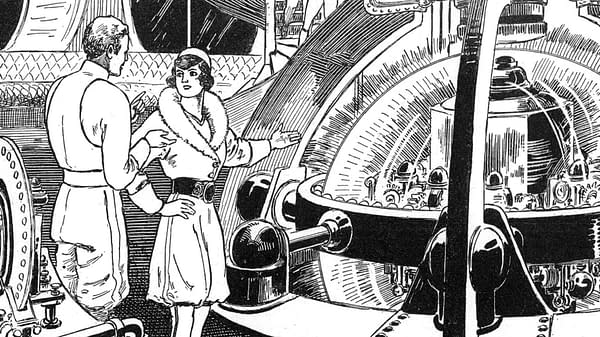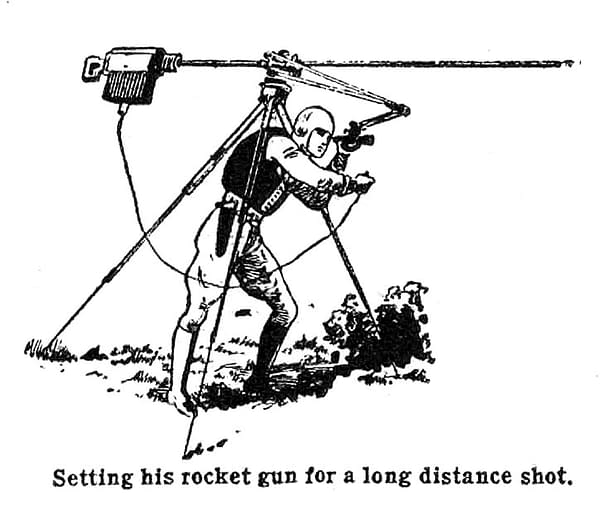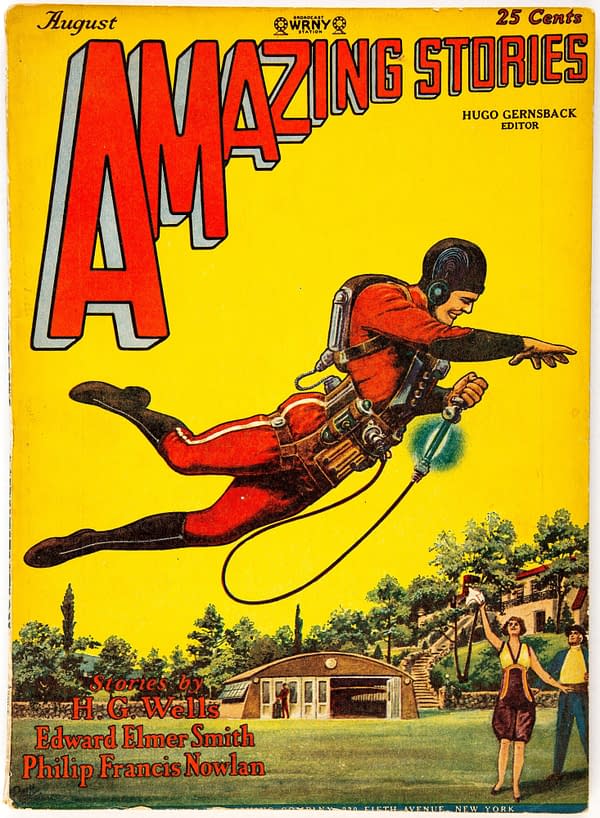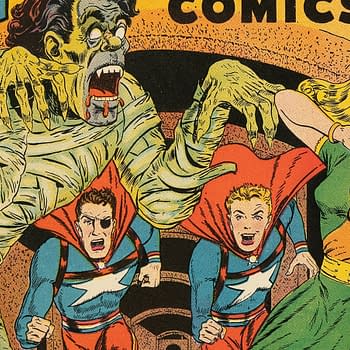Posted in: Comics, Heritage Sponsored, Vintage Paper | Tagged: amazing stories, buck rogers, pulps
The Amazing Stories Pulp That Influenced Science and Science Fiction
Even if you're unfamiliar with pulp fiction, chances are excellent that you've seen the cover of Amazing Stories volume 3 number 5, cover-dated August 1928. It has become perhaps the most famous cover of the pulp era because it's the image that is often used to represent the past's vision of the future. Looking beyond the cover to the stories inside the issue, Amazing Stories volume 3 number 5 is also the debut of one of the most important and influential science fiction characters in history: Buck Rogers. The character first appeared here in the story Armageddon 2419 by author Philip Francis Nowlan. If it's possible for an issue of a periodical to be both famous and underappreciated, this issue fits the bill. There's a Fine-condition copy of Amazing Stories volume 3 number 5 in this week's Amazing Pulps and Collectibles Auction featuring the Joe Rainone Collection at Heritage Auctions.

This iconic cover image doesn't feature Buck Rogers, but it's a historically important piece of work. The cover feature of this issue is actually the character Richard Seaton from E.E. Smith's The Skylark of Space, his first published work of science fiction. Important and influential science fiction and comic cover artist Frank R. Paul created this cover and provided several interior illustrations for Amazing Stories volume 3 number 5. As the blurb on the title page of the issue explains, "Our cover this month depicts a scene from the first installment in this issue of the story entitled THE SKYLARK OF SPACE, by Edward Elmer Smith and Lee Hawkins Garby, in which the scientist, who has discovered a chemical substance for the liberation of intra-atomic energy, is making his initial tests, preparatory to his interstellar flight by means of this liberated energy, which makes possible his interstellar space-flyer."
Buck Rogers, Skylark, and the Amazing Stories Influence
While Buck Rogers would quickly go on to success in comic strips, radio, and film, the combination of both The Skylark of Space and Buck Rogers proved to be irresistible and memorable to a number of important figures from comics and science fiction history. Superman creators Jerry Siegel and Joe Shuster were influenced by both concepts and their creators, as were many others. For example:
While Mortimer [Weisinger] early showed a prediction for the imaginative works of Jules Verne and Edgar Allan Poe, he balanced this tendency with a healthy interest in the Rover Boys and Motor Boy series. The fatal shift came when his parents sent him to a camp one summer and he borrowed the counselor's copy of the August 1928, AMAZING STORIES featuring in the same issue Armageddon 2419, the first Buck Rogers story, by Philip Francis Nowlan. and the opening installment of The Skylark of Space by Edward E. Smith, Ph.D.
[Gene Roddenerry] would remember E.E. "Doc" Smith's "Skylark" series for over fifty years.
Buck Rogers was a program not to be missed and Gene rarely did… Ray Bradbury once told Gene that he would get up early and sit on his front porch waiting for the morning newspaper to see what Buck did that day.

The Science and Science Fiction of E.E. Smith
A chemist by trade with a PhD in chemical engineering, E.E. Smith would go on to create work that would have an influence on the science and military technology of the subsequent decades. For example, in a letter from Astounding Science-Fiction editor John W. Campbell Jr. to Smith, Campell notes that he has been informed that the concept of the Combat Information Center was inspired by Smith's Grey Lensman:
CIC was introduced into the Navy scheme by a navy officer who was not then, nor is not now, able to explain to the Navy precisely where he got the idea.
Unofficially, and in confidence, he has told me.The entire set-up was taken specifically, directly, and consciously from the "Directrix." In your story, you reached the situation the Navy was in—more communication channels than integration techniques to handle it. You proposed such an integrating technique, and showed how advantageous it could be.
You, sir, were 100% right. As the Japanese Navy—not the hypothetical Boskonian fleet—learned at an appalling cost. Sitting in Michigan, some years before Pearl Harbor, you played a large share in the greatest and most decisive naval action of the recent war!
Unfortunately, in order that a Naval officer with imagination enough to apply the science-fiction ideas he studies may continue to have the maximum possible influence on the Navy, the source of his ideas—a source the Brass Hats wouldn't take to so well—must remain undisclosed. He's Capt. Cal Lanning. At present, he is in charge of all Naval electronic research, with special emphasis on advanced spy ray equipment, detector screens, and detector screen analysis techniques.
Buck Rogers and Robert H. Goddard
Buck Rogers would also go on to have a fascinating early influence of sorts on science — and one important scientist in particular. In the Buck Rogers comic strip, the look of the character Dr. Huer was was inspired by the world's most famous rocket scientist and the father of modern rocketry, Robert H. Goddard. And as noted in the 2003 biography of Goddard, Rocket Man:
In 1956, Esther Goddard told Milton Lehman that her husband had been proud of the association–once they even went out of their way to see a Buck Rogers exhibit in Chicago. Whenever there was a problem with Robert's rocket experiments, she said, she quoted Dr. Huer's refrain to him: "Now don't you worry, the old doctor will take care of that."

The Deductions of Philip Francis Nowlan
Unlike E.E. Smith, Philip Francis Nowlan did not have a formal education as a scientist. Six years younger than Robert H. Goddard, Nowlan was born in 1888. Before the late-1920s, he was primarily a newspaper, newspaper syndicate, and business magazine editor and writer who appears to have had outstanding research skills in a wide range of fields. Such skills were evident in infotainment-style syndicated newspaper columns such as History of Your Name and First Jobs of Big Men. As a business writer and editor who seems to have specialized in manufacturing industries, Nowlan brought a noteworthy acumen in math, economics and politics to his industry analysis. He was confident enough in his command of such matters to give a talk at a meeting of the Engineer's Club of Philadelphia in 1918.
Despite keeping busy with such endeavors, Nowlan also wrote a fair bit of fiction during this period as well, much of which is now little-known. Among his earliest published works of fiction is a short called Mars, Humorist in the May 1916 issue of The Black Cat — a now-obscure but incredibly important bridge between the dime novel and pulp eras which contains genre fiction from a number of important writers. The Deductions of Harvey Hunt is another noteworthy forgotten Nowlan syndicated newspaper serial endeavor that invited readers to solve clues as the story progressed.
Amazing Stories and the Spirit of Science Fiction
A passage from the forward of Armageddon 2419 in this issue of Amazing Stories points the way towards one of the sparks of inspiration that nudged Nowlan towards the creation of Buck Rogers:
When I began my long sleep, man had just begun his real conquest of the air in a sudden series of trans-oceanic flights in airplanes driven by internal combustion motors. He had barely begun to speculate on the possibilities of harnessing sub-atomic forces, and had made no further practical penetration into the field of ethereal pulsations than the primitive radio and television of that day. The United States of America was the most powerful nation in the world, its political, financial, industrial and scientific influence being supreme; and in the arts also it was rapidly climbing into leadership.
1927, the year prior to the publication of Amazing Stories volume 3 number 5 was an important year for man's real conquest of the air and beyond — not to mention trans-oceanic flights. It was also the year that the character Anthony Rogers (his name in his initial pulp appearances, it was changed to "Buck" for the subsequent newspaper strip) made the fateful investigation of an abandoned Pennsylvania coal mine, which ultimately put him into a state of suspended animation for 492 years.
Charles Lindbergh completed the first solo, non-stop transatlantic flight with his single-engine plane The Spirit of St. Louis on May 21, 1927. News of the historic flight and its implications had captured the world's imagination, and on the same day the flight was completed, the publicity-friendly Goddard was in newspapers around the country showing off a rocket design under the headline "Want to be the first to visit the Moon? Apply to Robert H Goddard, Clark University." Goddard was in the news again just weeks later floating the notion of "a passenger-carrying rocket for transatlantic service." By the end of the year, newspapers were carrying a depiction of a Goddard-proposed "inter-planetary rocket" that wouldn't have looked at all out of place in an issue of Amazing Stories.

Such events helped influence Philip Francis Nowlan and primed a mass media audience who were becoming ever more interested in the science of the future. Buck Rogers became a syndicated newspaper comic strip from John F. Dille Co. in 1929, written by Nowlan and drawn by Dick Calkins, who had been a pilot in World War I. The strip became so popular that it served to inspire other science fiction comic strips, such as Flash Gordon and John Carter of Mars. A Buck Rogers radio serial (1932), film serial (1939), and a 1979 television series eventually followed. Meanwhile, E.E. Smith would go on to become one of the most influential science fiction writers of the 1930s-1950s. And in 1930, Robert H. Goddard acquired new financial backing and moved his base of experimental operations to Roswell, New Mexico where he eventually garnered the support of the U.S. Air Force — making Roswell, well… Roswell.
Amazing Stories volume 3 number 5 was part of a confluence of events that helped take science fiction farther into the mainstream and change the world's perception of science. Its particular vision of the future remains imprinted in pop culture memory to this day. There's a Fine-condition copy of Amazing Stories volume 3 number 5 in this week's Amazing Pulps and Collectibles Auction featuring the Joe Rainone Collection at Heritage Auctions.

















